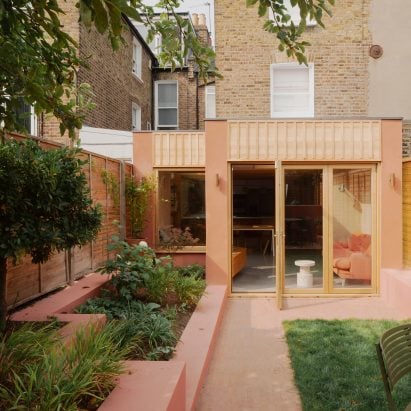Clay wall finishes and built-in oak joinery were used to add warmth and facility to this Victorian terraced house in south London, extended by British architecture studio Pensaer.
Named Clay House after the project’s use of the raw material, the home in East Dulwich has been expanded by 40 square metres with a side and rear extension.
Pensaer has extended a Victorian terraced house in London called Clay House
Pensaer‘s addition maximises natural light and improves the flow through the house, which originally had a rear kitchen with a low ceiling and poor connection to the outside.
The studio’s design also introduces multiple areas to sit, relax, and work, while aiming to respect the character of the original Victorian structure.
A clay-based render coats the exterior and interior walls
“The work has created an open, contemporary space that has a carefully considered connection to the garden,” studio founder Rhys Owen told Dezeen.
Clay House’s roof geometry has been designed to feel like one continuous sculptural form, with layered beams framing a large kitchen skylight that brings light deep into the plan.
A built-in bench features in the living space
To create a sense of continuity throughout Clay House, the exposed beams transition into oak wall shelving and a prominent window seat that looks out over the garden.
This built-in bench is one of the focal points of the project, providing a space for the clients to sit while bridging the gap between indoor and outdoor spaces.
Inspired by the idea of a “warm welcoming”, Pensaer’s design focuses on bringing harmony between materials and its muted colour palette.
The garden has also been reinvigorated with built-in seating and planting beds.
A skylight draws light into the kitchen
“We thought a lot about how to balance inside and outside, making sure the client felt connected to their garden,” said Owen.
“The interplay of warm oak, polished concrete, and natural light creates a harmonious dialogue between textures and tones.”
Natural materials have been priortised
Both Clay House’s exterior and interior walls are finished in a clay-based render, forming a backdrop to natural wood furniture and joinery. These are contrasted with polished concrete floors.
“By integrating natural materials with sculptural elements, we’ve designed a space that feels both grounding and uplifting,” said Owen.
Other house extensions finished with natural materials include Hemp House, designed by London practice Nimtim Architects with hempcrete and timber, and architect Michael Henriksen’s extension of his own home in St Albans using exposed clay-block walls, timber ceilings and cork flooring.
The photography is by Peter Molloy.
The post Pensaer prioritises natural materials for Clay House extension in London appeared first on Dezeen.
